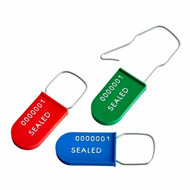Guarding Prime Targets of Cargo Thieves
Posted by Steve Diebold
THE ENORMITY OF EXPOSURE
Estimates from the National Cargo Security Council put annual cargo theft losses at around 50 Billion US Dollars. One estimate puts losses at about 20 Billion Dollars in the US alone. These are conservative figures. Cargo theft in total is a hard thing to measure. Reporting of cargo theft is mostly voluntary and much of it goes undiscovered or unreported.
Consumer electronics were once the most targeted item for theft in transit because of the high value. They continue to be a big target but no longer the top target. Around 2010 reports started showing a shift. The greatest target for theft in transit and storage became (and remains now) food and beverages. They are plentiful, easy to sell, and often almost impossible to trace.
Another factor in greater food theft is simply the massive amount of product in the market. Consumer electronics shipped and sold are estimated to be worth over 1 trillion dollars. Though near the top of the target list it pales next to the total worth of food and beverages. That world market is estimated to be worth about 7 times more than electronics. Also, the number and sizes of food conveyances are far more diverse and expansive. They present more targets in more places with broader access.
HOW CAN SEALS HELP?
Theft can come from inside or outside the owner’s property, staff or that of their contractors’. Seals and locks certainly cannot stop all cargo theft. But they are far from useless. The value of using seals is their ability to provide deterrence and detection. When you properly seal a trailer, a tanker, a cold storage space, a tank, drum, or other bulk handling asset or space you can help to reduce and even prevent losses.
The principles of seal use are the same for any industry or product group, whether electronics, jewelry. Clothing, food, chemicals, fuels or anything shipped or stored in accessible places. Security seals, once closed, will leave evidence when someone opens them, or attempts to. If you use them correctly you will know if something that was sealed has been opened.
Knowing a seal has been opened can include also knowing when, and if in transit, where the opening occurred. The process of tightening the known time or distance of discovery helps to investigate theft and eventually catch or scare away the thieves. The term “indicative seals” is appropriate here. Seals can “indicate” a problem. It will allow the user to detect the opening or violation of a closure. The rest is the work and integrity of the people using them.
The options for the type of indicative seals available are substantial. Buying them is not hard. The methods used to monitor and inspect these seals are important to know. AC&M offers an exceptionally broad range of indicative seals, and the expertise to help you use them effectively.
The indicative seal is especially useful when theft is taking place inside an operation through pilferage, skimming or dumping product from storage within a company’s facility or while in transit vehicles. Another important benefit of proper use of indicative seals is that clear evidence of entry gives the owner needed proof. That is essential for recovery of losses through insurance. Proper documentation of seal use and inspection can often make the difference in whether a claim can be paid. Without a properly managed and well documented program of sealing it is difficult (or impossible) to collect on cargo insurance claims.
WHEN INDICATIVE SEALS ARE NOT ENOUGH
This type of loss avoidance does not apply to bold theft of entire trailers or violent robbery. Those types of losses are another matter and require other deterrents and specialists in law enforcement.
However, high strength seals will slow down or keep out many who do not have strong enough tools or are looking to gain fast and simple entry, while leaving quickly. It is especially useful to have a high strength seal on long haul deliveries and often mandatory for international shipments. AC&M supplies a full range of high strength seals including those certified to meet standards of ISO-17712.
LET OUR EXPERIENCE HELP
For information about seals to protect your products, samples, recommendations, price quotes or other assistance we welcome your requests.
Our experienced experts are available during business hours in Eastern Daylight time zone by email, phone or online chat. Also, our web site offers comprehensive information, and the ability to order seals 24/7 from anywhere.

